Chartbook #1:
Children's Health 1996
By Margaret E. Weigers, Ph.D., Robin M. Weinick, Ph.D., and Joel W. Cohen, Ph.D.
Contents
Executive Summary
Return to Table of Contents
Return to Table of Contents
Introduction
Health Policy for Children
High-quality health care is important to the well-being of America's children. Recent policy changes have attempted to increase children's health insurance coverage and access to care so that children can obtain health care that is appropriate to their developmental needs.
In the last decade, the Medicaid program has been expanded to decrease the proportion of children who are uninsured. However, a substantial number of children still lack health insurance and adequate access to care. Consequently, they risk health problems associated with not being immunized, not receiving appropriate well-child care, and not receiving timely treatment for acute health problems.
In this era of rapid changes in our health care system, it is important
to assess periodically where we stand. This report presents the latest
available information concerning three key elements related to childrenís
health. The first section of the report presents data on the health
insurance status of children in the United States. Since having health
insurance is just one factor that may influence childrenís health and
well-being, the second section of the report addresses access to healthcare,
with
a focus on usual source of care and barriers to care. Finally, the
third section of the report turns to the motivating force behind our
Nationís
interest in childrenís health insurance and access to care: the health
status of children.
Return to Table of Contents
Source of Data for This Report
The estimates presented in this report are drawn from the Medical Expenditure Panel Survey (MEPS). MEPS is the third in a series of medical expenditure surveys conducted by the Agency for Health Care Policy and Research. It is a nationally representative survey that collects detailed information on health status, health care use and expenses, and health insurance coverage of individuals and families in the United States.
These data come from the first and second rounds of interviewing for the Household Component of the 1996 panel of MEPS. (See Note 1). The estimates presented here are nationally representative of noninstitutionalized children under age 18. In some cases, totals may not add precisely to 100 percent as a consequence of rounding. Where shown, the racial category "white" includes children identified as white as well as a very small number of children identified as American Indians, Aleuts, Eskimos, or other races.
MEPS data are released to the public in a number of formats, including public use data files and the printed "MEPS Research Findings" and "MEPS Highlights" series. The numbers shown in this Chartbook are drawn from a variety of the Research Findings reports, as well as additional analyses conducted by the MEPS staff. Select to access references for this report.
(Note 1) Data collection for Round 1 took place between March and July 1996 and asked about health-related issues for the period from January 1, 1996, to the date of the Round 1 interview. Round 2 data collection occurred during the period from August to November 1996 and asked survey respondents to report on health-related issues between the date of the first interview and the date of the second interview. All data concerning health insurance, health status, and demographics presented in this chartbook come from Round 1 of the survey. Health insurance and health status estimates should therefore be interpreted as estimates for experiences during the first half of 1996. Information on access to care was obtained in Round 2 of the survey; however, the questions on access to care generally did not ask about a specific time period.
Return to Table of Contents
Section
1—Children's Health Insurance
Health insurance plays a critical role in ensuring that children obtain timely medical care that is appropriate to their developmental needs. In an era of high health care costs, individuals' difficulty affording medical care has made health insurance essential for ensuring that children's health services are both accessible and affordable.
Children's health insurance: Where do we stand?
- 15.4% of the Nation's children were uninsured throughout the first half of 1996.
- One-fifth (20.8%) of children had public coverage.
- Almost two-thirds (63.9%) of the Nation's children were covered by private health insurance.
Health insurance status of children under age 18
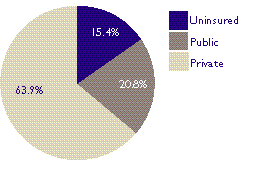
Return to Table of Contents
Who are the uninsured children?
- Nearly 11 million children in America were uninsured throughout the first half of 1996. These children represent 15.4% of all children in the United States.
- Of all children uninsured throughout the first half of 1996, about 90% were in households with a working adult.
- Children in families with a working adult represented over a fifth (22.1%) of the non-elderly uninsured population.
Are minority children at greater risk of not having health insurance?
- Hispanic children were the most likely to be uninsured: 27.7% of Hispanic children, 17.6% of black children, and 12.3% of white children were uninsured.
- White children were far more likely to have private health insurance (73.9%) than either black (41.7%) or Hispanic children (39.8%).
- Nearly a third (32.5%) of Hispanic children and 40.8% of black children had public health care coverage, compared to only 13.8% of white children.
Percent of children uninsured
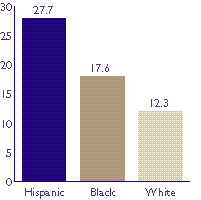
Return to Table of Contents
Are children in single-parent families at greater risk of not having private health insurance?
- Approximately one-quarter of children in the United States live in single-parent families.
- Roughly one in five children (19.8%) in single-parent families were uninsured during the first half of 1996, compared with 13.6% of children in two-parent families.
- Nearly three-quarters (73.7%) of children in two-parent families had private insurance, compared with only 38.7% of children in single-parent households.
- Children in single-parent families were three times more likely to have public insurance than children in two-parent families (41.5% compared to 12.7%).
Family structure and health insurance status of children
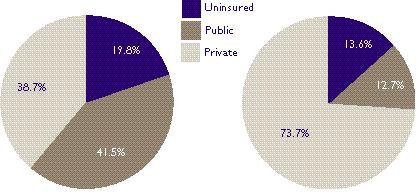
| Single-Parent Families |
Two-Parent Families |
Return to Table of Contents
How do parents' employment and education levels affect children's health insurance?
Employment
Children living with two employed parents were the most likely to have employment-related private health insurance.
- 79.1% of children living with two employed parents had health insurance through an employer.
- 58.8% of children in two-parent households with one working parent had health insurance through an employer.
- 51.1% of children in single-parent households with a working parent had employment-related health insurance.
Education
Adults' educational level greatly influenced the probability of children being insured.
- 27.6% of children living in families where adults had less than a high school diploma were uninsured.
- Only 10.6% of children living in families where adults had more than 12 years of education were uninsured.
Return to Table of Contents
How did recent Medicaid expansions affect the health insurance status of children?
- Medicaid expansions between 1987 and 1996 resulted in more generous eligibility rules for children. During the same period, the proportion of children covered by Medicaid increased from 12.4% to 20.9%.
- Young children were targeted by the expansions, and 1996 estimates show that the largest increase was among that group. Medicaid enrollment among children 5 and under nearly doubled, from 13.8% in 1987 to 25.8% in 1996.
- Approximately 9.4 million children under the age of 18 who were eligible for Medicaid in 1996 would not have qualified for coverage under the 1987 rules.
Medicaid enrollment of children by age group, 1987 and 1996
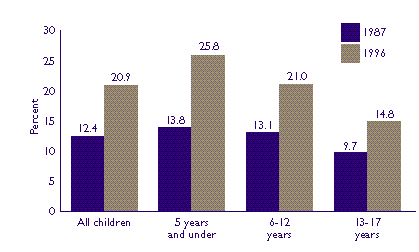
Return to Table of Contents
Are all the children who are eligible for Medicaid enrolled in the program?
Medicaid expansions have increased access to health insurance for children. However, many Medicaid-eligible children still are not enrolled.
- Of the estimated 16.6 million children age 12 and under who were eligible for Medicaid, approximately 3.3 million (19.7%) were uninsured during the first half of 1996, 4.4 million (26.6%) had private coverage, and 8.9 million (53.7%) had public coverage. (See Note 2.)
- In addition, MEPS estimates indicate that more than 1 million children age 13 and over were uninsured despite being eligible for Medicaid.
Insurance status of Medicaid-eligible children age 12 and under
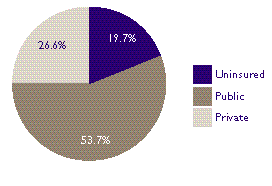
Return to Table of Contents
(Note 2) Estimates include children made eligible under both Federal and State Medicaid expansions. Children age 12 and under are defined as those born after September 30, 1983. Eligibility was predicted for each person in Round 1 of MEPS based on age, gender, pregnancy status, family composition, employment status of parents, and family earned income. Earned income was computed using data on wages and hours worked for all jobs as of the interview week. The Medicaid eligibility measure does not account for disabled children or adults.
The estimates presented here for young children differ from other widely cited estimates for children age 10 and under, primarily because 11- and 12-year-olds who became eligible under the Federal expansion rules in effect in 1996 are included. In addition, children who are eligible under optional State expansions are included, and eligibility is predicted using weekly earned income rather than annual income from all sources.
Return to Table of Contents
What is the employment status of parents of children on Medicaid?
- 40.1% of Medicaid-enrolled children under the age of 18 lived with one employed parent.
- An additional 12.7% of Medicaid-enrolled children under 18 lived with two employed parents.
Employment status of parents of Medicaid-enrolled children
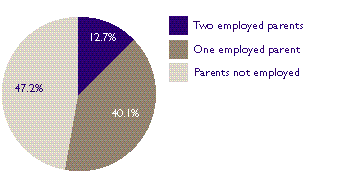
Return to Table of Contents
Section 2—Children's Access to Health Care
Having adequate access to health care services can significantly influence health care use and health outcomes. Consequently, measures of access to care are an important tool for evaluating the quality of the Nation's health care system. Limitations in access to care extend beyond such simple issues as a shortage of health care providers or facilities in some areas. Even where health care services are readily available, people may not have a usual source of health care or may experience barriers to receiving services because of financial or insurance restrictions, a lack of availability of providers at night or on weekends, or other difficulties.
One extensively studied indicator of access is having a usual source of care.
Do children have a place to go when they are sick or need health care?
Persons with a usual source of health care have been shown to be more likely to receive a variety of preventive health services than those without a usual source of care. However, all usual sources of care are not the same. Office-based sources may cost less and provide better continuity of care.
- Children aged 13-17 were less likely than younger children to have a usual source of health care.
- Children aged 13-17 were also less likely to have an office-based usual source of health care.
Children's usual source of care, by age group
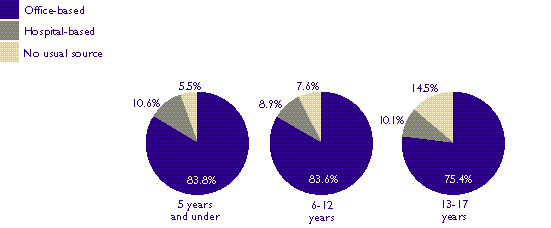
Return to Table of Contents
Are minority children at greater risk of not having a usual source of care?
- Hispanic and black children were less
likely than white children to have a usual source of care and less
likely to
have an office-based usual source of care.
- Hispanic
children were less likely than children in any other racial/ethnic
group to have a usual source of health care.
- Black children were less likely than white children to have a usual source of health care.
- Hispanic and black children were less likely than white children to have an office-based usual source of care, and were more likely to have a hospital-based usual source of care.
Children's usual source of care, by race/ethnicity
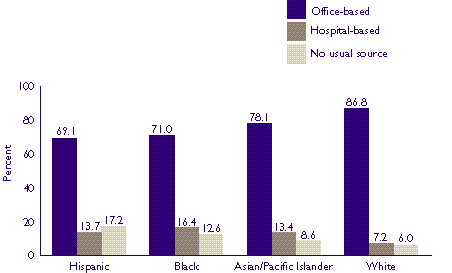
Return to Table of Contents
Does health insurance affect children's chances of having a usual source of care?
- Children with private health
insurance were more likely to have a usual source of care than
those who had public insurance or were uninsured.
- 20.2% of uninsured children lacked
a usual source of health care.
- Children who were uninsured were 3.6 times more likely to lack a usual source of care when compared to children with private insurance.
- Children who were uninsured were twice as likely as those with public insurance to lack a usual source of care.
Percent of children with no usual source of care, by health insurance status
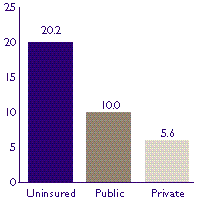
Return to Table of Contents
Do children with a usual source of care get the care they need when they need it?
Characteristics of usual sources of health care that can affect access to care include having office hours at times when parents are not working and being easy to contact by phone. Among children under age 18 who had a usual source of care:
- 40.6% had a provider who did not have night and weekend office hours.
- 22.1% of these children's families found their usual source of care providers "somewhat" or "very" difficult to contact by telephone.
How satisfied are families with their usual source of care?
Satisfaction and continuity of care are important aspects of high-quality health care. Families of children with a usual source of care reported that:
- 97.5% were "somewhat" or "very" satisfied with their usual source of care.
- 96.9% had a usual source of care provider who generally listened and gave them needed information about health and health care.
- 74.9% had a usual source of care provider who generally asked questions about prescription medicines and treatments from other doctors.
Return to Table of Contents
Why don't some children have a usual source of care?
While more than 91% of children under age 18 had a usual source of care, 8.8% had no usual source of health care. Of these:
- 65.9% had no usual source of care because they seldom or never got sick.
- 7.8% had no usual source of care because they recently moved to the area or did not know where to receive care.
- 10.0% had no usual source of care because their families could not afford medical care.
Main reasons for children not having a usual source of care
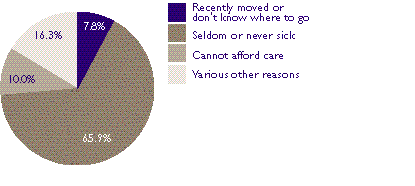
Return to Table of Contents
Why don't some families get health care when they need it?
Approximately 12.8 million families (11.6% of all American families) experienced difficulty or delay in obtaining care, or did not receive needed health care services. (See Note 3.)
- Among these families, inability to afford health care was cited by the majority (59.9%) as the main problem. Another 19.5% cited insurance-related reasons as the main obstacle to receiving care. (See Note 4.)
- Families with a Hispanic head of household, or with one or more uninsured members, were substantially more likely to report experiencing barriers to receiving needed health care.
Reported barriers to families receiving needed care
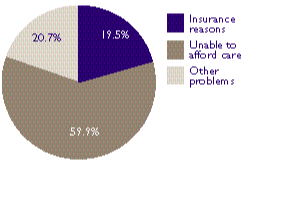
(Note 3) The statistics about "Why don't some families get health care when they need it?" are not limited to families with children.
(Note 4) Insurance-related reasons include "insurance company wouldn't approve, cover, or pay for care," "pre-existing condition," "insurance required a referral but couldn't get one," and "doctor refused to accept family's insurance plan."
Return to Table of Contents
Section
3—Children's Health Status
One main objective of our health care system is to maintain and improve American children's health. Consequently, children's health outcomes provide one indication of how well the system is functioning.
Answers to simple questions like the one reported here (which asked "Would you rate this child's health as excellent, very good, good, fair or poor?") have been shown to predict both demand for medical care services and medical outcomes.
Return to Table of Contents
Children's health status: Where do we stand?
- 80.2% of all children under the age of 18 were in excellent or very good health.
- Less than 1% of children were in poor health.
- Although they represent just under 4% of all American children under the age of 18, 2.8 million children were in fair or poor health.
Health status of children
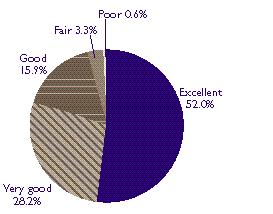
Return to Table of Contents
Are minority children at greater risk of poor health?
Children's health status varies by racial and ethnic group. This may in part be explained by differences in access to adequate health care.
- Hispanic children were more likely than black or white children to be in fair or poor health (7.8% of Hispanic children, compared with 4.2% of black children and 2.9% of white children).
- Black and Hispanic children were less likely than white children to be in excellent health (48.1% of black children and 42.9% of Hispanic children, compared with 55.1% of white children).
Perceived health status of children, by race
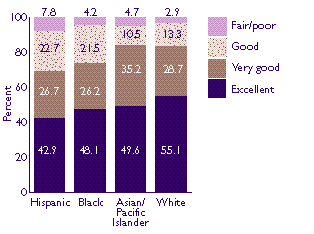
Return to Table of Contents
Where do children in fair or poor health get their health insurance?
Children in fair or poor health were far more likely than children in excellent health to have public insurance. Children in excellent health were more likely to have private insurance. Because of public health care coverage, children with health problems were as likely to be insured as children in excellent health.
- Of children in fair or poor health, only 42.8% had private health insurance and 41.8% had public health insurance. Of children in fair or poor health, 15.4% had no insurance coverage.
- Of children in excellent health, 70.1% had private health insurance coverage, while 15.1% had public health insurance and 14.8% were uninsured.
Children in fair/poor health—Children in excellent health
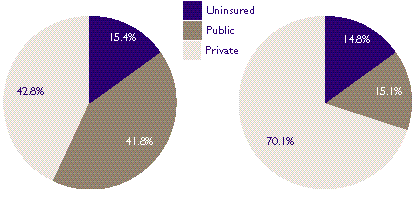
Return to Table of Contents
Conclusions
The data presented in this report suggest that:
- In spite of various policy initiatives, a substantial number of children in America remain uninsured.
- Black and Hispanic children are at increased risk of adverse outcomes, including being uninsured and being in poor health.
- Having a working parent is not enough to ensure children's access to private health insurance.
- The most common reason children do not get needed health care is because their families cannot afford it.
- Public coverage is a critical factor in providing insurance for children with health problems.
Return to Table of Contents
Looking Ahead—Future MEPS Data on Children
This report presents estimates of children's health insurance coverage, access to health care, and health status. Future data from MEPS will address a number of additional aspects of children's health care, including:
- The impact of managed care.
- Use of specific services.
- Use of preventive health services, including immunization status.
- Amounts paid for health care and sources of payment.
- Additional measures of health status, including health conditions and functional limitations.
- Changes in children's health insurance status over time.
- Amounts families pay for private health insurance coverage.
MEPS is a unique data resource for monitoring our Nation's health care system. As an ongoing survey, MEPS will produce data that can be used to examine changes over time.
Return to Table of Contents
References
Agency for Health Care Policy and Research. Medical Expenditure Panel Survey Insurance Status Tables: First Half of 1996. Rockville (MD); 1997, AHRQ Pub. No. 97-R052.
Banthin JS, Cohen JW. Changes in the Medicaid community population, 1987-1996. Paper presented at the 1997 Annual Meeting of the Association for Health Services Research.
Monheit AC, Vistnes JP. Health insurance status of workers and their families: 1996. Rockville (MD): Agency for Health Care Policy and Research; 1997. MEPS Research Findings No. 2. AHRQ Pub. No. 97-0065.
Vistnes JP, Monheit AC. Health insurance status of the civilian noninstitutionalized population: 1996. Rockville (MD): Agency for Health Care Policy and Research; 1997. MEPS Research Findings No. 1. AHRQ Pub. No. 97-0030.
Weinick RM, Zuvekas SH, Drilea SK. Access to health care—sources and barriers, 1996. Rockville (MD): Agency for Health Care Policy and Research; 1997. MEPS Research Findings No. 3. AHRQ Pub. No. 98-0001.
Weinick RM, Monheit AC. Family structure and children's health insurance coverage, 1977-1996. Paper presented at the 1997 Annual Meeting of the Association for Health Services Research.
Current as of March 1998.
AHRQ Pub. No. 98-0008.
Return to Table of Contents
Suggested Citation:
Weigers, M. E., Weinick, R. M., and Cohen, J. W.
Chartbook #1: Children's Health 1996. March 1998. Agency
for Healthcare Research and Quality, Rockville, MD. http://www.meps.ahrq.gov/data_files/publications/cb1/cb1.shtml |
|
